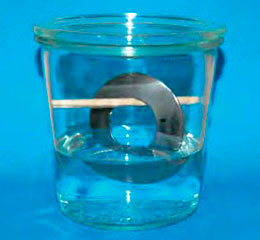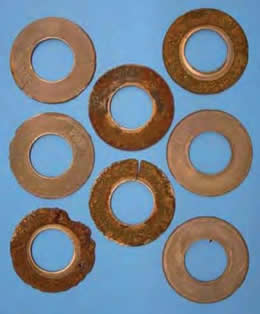CORROSION TESTS WITHOUT TENSION
 This test was carried out by immersing the pieces in different aggressive solutions. The pieces have been submerged without any effort applied, therefore free of internal tensions. This is why the results of this test show us the behavior of stainless steels and coatings used in different corrosive media.
This test was carried out by immersing the pieces in different aggressive solutions. The pieces have been submerged without any effort applied, therefore free of internal tensions. This is why the results of this test show us the behavior of stainless steels and coatings used in different corrosive media.
Tests were carried out at room temperature and without the introduction of air into the medium. The results have been obtained after 4 weeks of immersion in the solution.
The washers used are pieces in two types of stainless steel with different manufacturing methods and others in standard steel, with several anticorrosive protections different between them.
Details of each of the corrosive solutions, as well as a description of the pieces characteristics used in the tests, can be found on the methodology page of the tests.
In the following table we can see the results of the tests:
| Variants | Different Aggressive Solutions | |||
|---|---|---|---|---|
| Spring + Material + Manufacturing Method | 40% MgCl2 | 3% NaCl | 0,1 n NaOH | 0,1 m ácido |
| C-63 - 1.4310 - Stamping - Grinding | M | G | G | G |
| C-63 - 1.4310 - Stamping - Grinding - Shot Peneed | M | G | G | G |
| B-80 - 1.4310 - Stamping - Grinding | M | G | G | G |
| C-63 - 1.4568 - Stamping - Grinding | M | G | G | G |
| C-63 - 1.4568 - Stamping - Grinding - Shot Peneed | P | M | G | G |
| C-63 - 1.4568 - Stamping - Grinding - Shot Peneed - Kolsterised | VP | P | G | G |
| 51 CrV4 | ||||
| Yellow Galvanized | G | P | G | VP |
| Transparent Galvanized | G | M | G | VP |
| Dacromet | G | G | G | VP |
| Geomet | G | G | G | VP |
| Delta Tone + Delta Seal | G | M | G | P |
| Nickel Plating | P | P | G | P |
| Paint diluted in water | G | G | M | P |
| Oiled | VP | VP | G | VP |
- G - Good (No signs of corrosion are evident)
- M - Moderate (Low manifestation of signs of corrosion, some points)
- P - Poor (Surface covered with a thin layer of corrosion)
- VP - Very Poor (Surface covered with a layer of considerable thickness of corrosion)
- 40% MgCl2: Magnesium Chloride
- 3% NaCl: Sodium Chloride
- 0,1 n NaOH: Sodium Hydroxide
- 0,1 m ácido: Citric acid
- C-63: 63 x 31 x 1,8 (DIN 2093)
- B-80: 80 x 41 x 3,0 (DIN 2093)
- Kolsterised: Treatment that improves the resistance to wear in austenistic stainless steel.
- Room temperature
- Without introduction of air in the middle
Conclusions
In the light of the results, there are some interesting facts to comment on.

- Stainless steel presents a low resistance to corrosion in 40% magnesium chloride MgCl2.We must say that in the case of 1.4310, the shot peneed treatment improves somewhat the resistance in this medium. However, in the case of 1.4568 this treatment further worsens its resistance to corrosion, being its version Kolterised , which shows the worst performance in stainless steels.
- On the other hand, the coatings in general, show a better behavior in the 40% magnesium chloride MgCl2solution, than the stainless steels. This is true, except in the case of nickel plating, and of course in oiling that is used as a simple storage method.
- In the solution of sodium chloride 3% NaCl, the stainless steels are effective. Here, however, most coatings clearly reduce their resistance. This doesn’t happen in case of Dacromet, Geomet and painting, which maintain their resistance to the medium.
- Both steels and coatings have a good tolerance to sodium hydroxide 0.1N NaOH. Only the paint is affected, due to the ability of this medium to dissolve it.
- As for citric acid (C8H8O7) 0.1M, the need to use stainless steel is clearly shown. The coatings show a low resistance to corrosion in this medium especially those with zinc coating, that is because this one reacts with the acid dissolving them at different speeds. In the attached photo we can see the result of some galvanized pieces after being submerged in citric acid.
